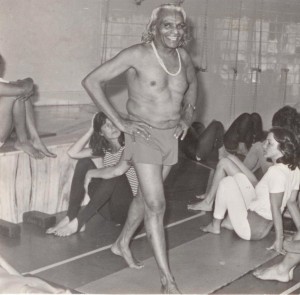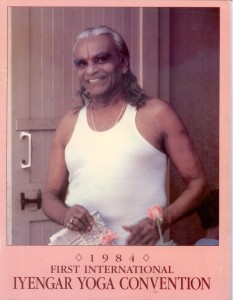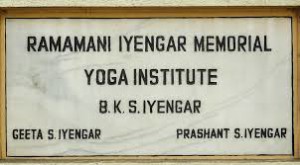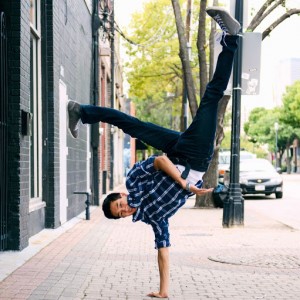 In honor of what would be B.K. S. Iyengar’s 96th birthday this coming Sunday, I decided to reprint the mini biography I wrote for the souvenir program for the attendees of the 1984 International Yoga Convention held in San Francisco. He was 65 that summer, just about my age now. He had already accomplished so much, and yet, from our perspective in 2014, we can see he was just getting started.
In honor of what would be B.K. S. Iyengar’s 96th birthday this coming Sunday, I decided to reprint the mini biography I wrote for the souvenir program for the attendees of the 1984 International Yoga Convention held in San Francisco. He was 65 that summer, just about my age now. He had already accomplished so much, and yet, from our perspective in 2014, we can see he was just getting started.
It is impossible to overstate the effects that this one man has had on the planetary and cosmic levels of consciousness emerging in the human in the early years on the millennium. Great achievements generate admiration and respect, but Guruji’s life evokes unfathomable awe. He was certainly very human. He had insecurities and emotional confusion like all of us. But when he was grounded in the cosmic field, his genius knew no boundaries, and he kept on channeling somatic brilliance right up to the end. May we all find the inner light of yoga, and all those ‘clues’ he left us, that will guide our own continuous pursuit of the ever elusive excellence he so embodied.
The Genius of B.K.S. Iyengar can scarcely be appreciated by even his most senior students. For over fifty years Mr. Iyengar has been applying his incredible strength of will, his keen penetrating mind and brilliant intuitive perceptions to the exploration of the art of  yoga. The subtlety of his insight has enabled him to refine this ancient practice to a degree of scientific precision that is awe-inspiring in its simplicity and completeness. The artistic beauty of his asanas reflect an inner harmony with the universe that is breath-taking to behold. His therapeutic applications of asana and pranayama to treat a whole spectrum of ailments have astounded medical practitioners from all over the globe. His ability to infuse his students with the fiery discipline of tapas has generated a renaissance in the study of yoga that has spread to six continents. We are greatly honored to have Mr. Iyengar with us in the United States this summer and are especially privileged to have him honor us with a lecture demonstration on the art and practice of yoga.
yoga. The subtlety of his insight has enabled him to refine this ancient practice to a degree of scientific precision that is awe-inspiring in its simplicity and completeness. The artistic beauty of his asanas reflect an inner harmony with the universe that is breath-taking to behold. His therapeutic applications of asana and pranayama to treat a whole spectrum of ailments have astounded medical practitioners from all over the globe. His ability to infuse his students with the fiery discipline of tapas has generated a renaissance in the study of yoga that has spread to six continents. We are greatly honored to have Mr. Iyengar with us in the United States this summer and are especially privileged to have him honor us with a lecture demonstration on the art and practice of yoga.
Bellur Krishnamachar Sundara Iyengar was born on December 14, 1918, in what is now part of the Karntaka state in India. As the 11th of 13 children, ten of whom survived, young sundara had numerous brothers, sisters and in-laws. One of his brothers-in-law, Professor  T. Krishnamachar, a great scholar, student and teacher of yoga, became Sundara’s Guruji in 1935, initiating him with the Gayatri Mantra, and teaching him a few asanas. The early years of practice were extremely difficult for Sundara, whose weak constitution and stiff body made the practice of he asanas quite painful. Guruji was a kind-hearted but hot tempered man and his young student was too timid to complain. But Iyengar was a fast learner. Within a few months he gave his first public performance and soon after that was asked to train other students.
T. Krishnamachar, a great scholar, student and teacher of yoga, became Sundara’s Guruji in 1935, initiating him with the Gayatri Mantra, and teaching him a few asanas. The early years of practice were extremely difficult for Sundara, whose weak constitution and stiff body made the practice of he asanas quite painful. Guruji was a kind-hearted but hot tempered man and his young student was too timid to complain. But Iyengar was a fast learner. Within a few months he gave his first public performance and soon after that was asked to train other students.
The next several years saw him traveling about the region, demonstrating the asanas to the Maharajahs, doctors, professors and others. In 1937, his Guruji asked him to travel to Poona to start a yoga program at one of the colleges, and Poona has remained Iyengar’s  home to this day. For the next nine years he persevered in his practice and teaching, in spite of serious financial difficulties. Students interests waxed and waned and income was non-existent for long periods of time. Many a day was spent without solid food. Physical exhaustion and emotional depression were constant companions. In 1943, through the arrangements of his family, Iyengar married a 16 year old girl, Ramamani. She became his life long friend, “guardian angel”, and source of tremendous emotional support during the difficult years. Their first daughter, Geeta, was born in 1944 and the family later grew to include five daughters and a son, Prashant.
home to this day. For the next nine years he persevered in his practice and teaching, in spite of serious financial difficulties. Students interests waxed and waned and income was non-existent for long periods of time. Many a day was spent without solid food. Physical exhaustion and emotional depression were constant companions. In 1943, through the arrangements of his family, Iyengar married a 16 year old girl, Ramamani. She became his life long friend, “guardian angel”, and source of tremendous emotional support during the difficult years. Their first daughter, Geeta, was born in 1944 and the family later grew to include five daughters and a son, Prashant.
By 1946 the fortunes had begun to turn for the better. More people were becoming interested in Mr. Iyengar’s teachings and he was having success in treating various maladies with the yoga asanas. The next few years saw his fame and reputation grow. In 1948, Shri J. Krishnamurti, the well known philosopher, visited him in Poona and Mr. Iyengar helped him with his asana and pranayama practice. This began a relationship that would continue for another twenty years. The West became aware of Mr. Iyengar’s work in the early 1950’s, with Yehudi Menuhin playing an instrumental role. Mr. Iyengar accompanied him to Switzerland in 1954 and returned again in 1956. By the early 1960’s he was regularly conducting workshops in Europe, training western students in the art of yoga. “Light on Yoga was published in 1964 and soon the entire world became aware of Mr. Iyengar’s genius.
In 1973, Ramamani died quite suddenly at an untimely age. This came as quite a shock to  family and friends alike as she was beloved by all. It was at this time that plans were being drawn for a new yoga institute in Poona, and in January of 1975, The Ramamani Iyengar Memorial
family and friends alike as she was beloved by all. It was at this time that plans were being drawn for a new yoga institute in Poona, and in January of 1975, The Ramamani Iyengar Memorial  Yoga Institute was inaugurated. Thousands of yoga students from India and all over the world have traveled to Poona to study there.
Yoga Institute was inaugurated. Thousands of yoga students from India and all over the world have traveled to Poona to study there.  Today much of the teaching is done by Geeta and Prashant, Two of Iyengar’s children and excellent yogis in their own right. The classic treatise, ‘Light on Pranayama, Iyengar’s most recent book, was published in 1981. This all encompassing guide to that powerful yet infinitely subtle art stands, in the words of Sri Krishnamacharya, as “a precious gem in the firmament of yoga.”
Today much of the teaching is done by Geeta and Prashant, Two of Iyengar’s children and excellent yogis in their own right. The classic treatise, ‘Light on Pranayama, Iyengar’s most recent book, was published in 1981. This all encompassing guide to that powerful yet infinitely subtle art stands, in the words of Sri Krishnamacharya, as “a precious gem in the firmament of yoga.”
B.K.S. Iyengar has dedicated his life to passing along the knowledge and wisdom that he has learned. That so many of us are slow to catch on to what he is saying must be extremely frustrating to him. There is so much that he ca teach us, if we can only accelerate the learning process. But he always maintains his sense of humor in the face of our human frailty. As he often says with a mischievous look in his eyes, “I have given you the clue.” The seeds of his wisdom will continue to sprout in our consciousness for any years to come. With unswerving faith and dedication to the art of yoga, Mr. Iyengar has proven that one person can have a tremendous effect in the world. May we all be so inspired in our own lives so that our practice may help bring peace and sanity to the planet.
Editor’s Note: Bibliographical information was taken from “Body the Shrine, Yoga the Light“, published by the B.K.S. Iyengar 60th Birthday Celebration Committee, 1978.







